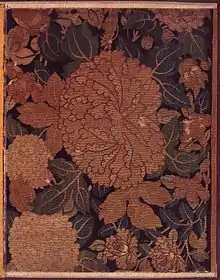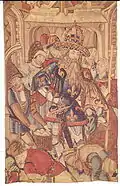Kesi (tapestry)
Kesi (simplified Chinese: 缂丝; traditional Chinese: 緙絲; pinyin: kèsī; K'o-ssu in Wade-Giles) is a technique in Chinese silk tapestry, admired for its lightness and clarity of pattern. It is a tapestry weave, normally using silk on a small scale compared to European wall-hangings. Clothing for the court was one of the main uses. The density of knots is typically very high, with a gown of the best quality perhaps involving as much work as a much larger European tapestry. Initially used for small pieces, often with animal, bird and flower decoration, or dragons for imperial clothing, under the Ming dynasty it was used to copy paintings.
| Wikimedia Commons has media related to K'o-ssu. |

"K'o-ssu" means "cut silk", as the technique uses short lengths of weft thread that are tucked into the textile. Only the weft threads are visible in the finished fabric. Unlike continuous weft brocade, in k'o-ssu each colour area was woven from a separate bobbin, making the style both technically demanding and time-consuming.
K'o-ssu first appeared during the Tang Dynasty (618–907), and became popular in the Southern Song Dynasty (1127–1279), reaching its height during the Ming dynasty (1368–1644). The style continued to be popular until the early 20th century, and the end of the Qing Dynasty in 1911–12.
Sources and external links
- "Kesi" — Encyclopædia Britannica Premium Service (retrieved 19 November 2020)
Further reading
- Watt, James C.Y.; Wardwell, Anne E. (1997). When silk was gold: Central Asian and Chinese textiles. New York: The Metropolitan Museum of Art. ISBN 0870998250.
- Mailey, Jean, The Manchu Dragon: Costumes of the Ch'ing Dynasty, 1644–1912, 1980, Metropolitan Museum of Art, fully online
- Preist, Alan, Simmons, Pauline, Chinese Textiles: An Introduction to the Study of their History, Sources, Technique, Symbolism, and Use, 1934, Metropolitan Museum of Art, fully online
